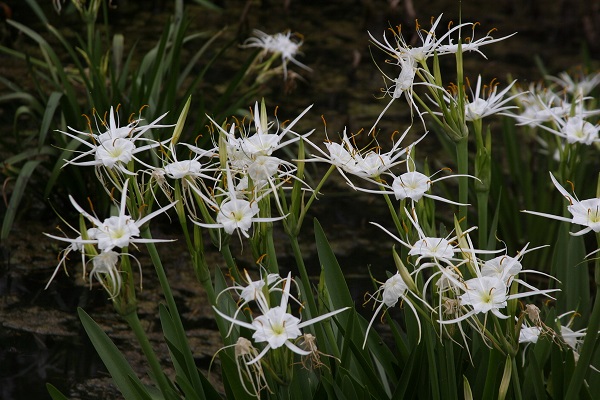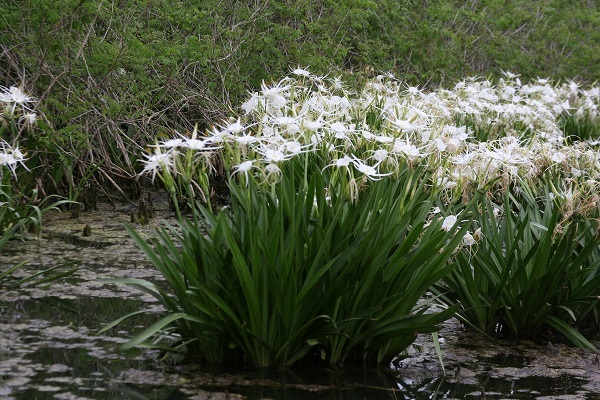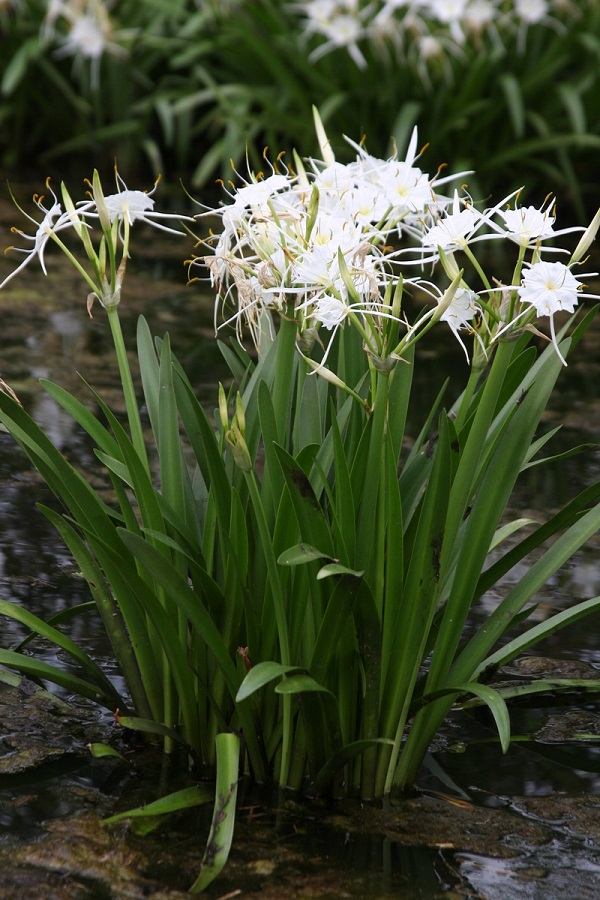

This native lily is also known as the "Texas Spider Lily." Every April, these spidery white blooms begin to appear in wetland areas across Texas and the Southeastern United States. They make large clumps and showy displays in settings that are often too hostile to other bulbs and plants. The flowers fade as we head into May, but the show is well worth it! They produce multiple softball-size blooms atop strong stalks amid dark green foliage. In pond areas, they look like islands of white color!

We can start with a lot of things to say about the "Texas Spider lily", but let's just start with that it is one-of-a-kind and one of the only natives we readily grow and promote. As gardeners, we are always looking for something to make our garden beautiful yet connected to our environment as well. The "Texas Spider lily" offers a unique opportunity to satisfy both of those goals. As a native though, we want to be very clear on something. Natives like to be in specific conditions.

Appearance: When the "Texas Spider lily" blooms, the white "spiders" sit on tall, narrow stems. The dark green stems usually stand about 2 feet tall, but they can grow up to 3 feet tall depending on the conditions. The blooms usually appear in April, and the white blooms cluster to create a softball-size clump. The Hymenocallis liriosme is distinguished from other varieties by the yellow center deep in the bloom's center. The "Texas Spider lily" has a light sweet fragrance.

Resilient: The "Texas Spider lily" is a hardy plant that can grow in zones 8-10. This bulb needs to be planted in an area that is extremely wet in the spring and dry in the summer. WARNING: Native flowers and bulbs can be hard to sometimes adapt to modern landscapes. Please note that the native habitat for this bulb is an environment in which it is extremely wet in the spring, and dry in the summer.
Uses for this Bulb: Some examples of this would be fields that have standing water in the spring but dry out in the summer, spillways from lakes or ponds that over flow in the spring but don't in the summer, stream banks that are high in the spring and low in the summer, bar ditches that collect water in the spring off the side of a road, etc.
Urban examples of use for this water loving flower include detention areas required for commercial construction, natural drainage areas that need native plants and aren't easily mowed, or areas that have clean water requirements and needs plants to help filter the water before it drains off site.
The bulbs are smaller than what you would expect for the amount of blooms they eventually put out once they are mature. We have them circling the farm ponds at the Southern Bulb Company farm. In August, these ponds are lower and dry around the banks...the bulbs love it, and bloom in standing water in April when the ponds are high.

Native and History: This bulb is a native Texas bulb. It can endure the tough weather that Texas has to offer especially the hot dry summer in full sun. We have an early historical account of this bulb in the State of Texas. In the early to mid-1800's, explorer Jean Louis Berlandier, a Swiss-French botanist, charted the plants of Mexico, an area that included sections of present-day Texas. In his journal he describes a scene where his expedition party that hiked from San Antonio to Rusk, TX found itself surrounded by knee-high white lilies. Many believe these flowers were the white spidery blooms of Hymenocallis liriosme. Berlandier wrote of many interesting aspects of life in Texas in the mid 1850's, such as foot long fresh water prawns from the rivers taken to open markets in San Antonio in wooden wheel barrows. Alas, abundant foot long fresh water prawns in Texas rivers can no longer be found. However, the botanical displays of these white spider lilies have persisted and can still be enjoyed today! Drive county roads in April, and you could find yourself in the middle of these spectacular beauties. We're excited to offer them to our customers!

You will receive small to medium bulbs in this special offer. The bulbs were harvested from our wet spring soil so be prepared for them to look this way. The best thing that you can do is to plant them as soon as possible in conditions similar to their native environment - somewhere wet right now that will be dry this summer. We know that this means digging in the mud, but you are doing this for the bulbs and for the beautiful stand that you will have in the future!
If we are sold out, contact our office to be put on a waiting list for the Texas Spider Lily! You can email us at info@southernbulbs.com or call us at 1-888-285-2486.
This native lily is also known as the "Texas Spider Lily." Every April, these spidery white blooms begin to appear in wetland areas across Texas and the Southeastern United States. They make large clumps and showy displays in settings that are often too hostile to other bulbs and plants. The flowers fade as we head into May, but the show is well worth it! They produce multiple softball-size blooms atop strong stalks amid dark green foliage. In pond areas, they look like islands of white color!

We can start with a lot of things to say about the "Texas Spider lily", but let's just start with that it is one-of-a-kind and one of the only natives we readily grow and promote. As gardeners, we are always looking for something to make our garden beautiful yet connected to our environment as well. The "Texas Spider lily" offers a unique opportunity to satisfy both of those goals. As a native though, we want to be very clear on something. Natives like to be in specific conditions.

Appearance: When the "Texas Spider lily" blooms, the white "spiders" sit on tall, narrow stems. The dark green stems usually stand about 2 feet tall, but they can grow up to 3 feet tall depending on the conditions. The blooms usually appear in April, and the white blooms cluster to create a softball-size clump. The Hymenocallis liriosme is distinguished from other varieties by the yellow center deep in the bloom's center. The "Texas Spider lily" has a light sweet fragrance.

Resilient: The "Texas Spider lily" is a hardy plant that can grow in zones 8-10. This bulb needs to be planted in an area that is extremely wet in the spring and dry in the summer. WARNING: Native flowers and bulbs can be hard to sometimes adapt to modern landscapes. Please note that the native habitat for this bulb is an environment in which it is extremely wet in the spring, and dry in the summer.
Uses for this Bulb: Some examples of this would be fields that have standing water in the spring but dry out in the summer, spillways from lakes or ponds that over flow in the spring but don't in the summer, stream banks that are high in the spring and low in the summer, bar ditches that collect water in the spring off the side of a road, etc.
Urban examples of use for this water loving flower include detention areas required for commercial construction, natural drainage areas that need native plants and aren't easily mowed, or areas that have clean water requirements and needs plants to help filter the water before it drains off site.
The bulbs are smaller than what you would expect for the amount of blooms they eventually put out once they are mature. We have them circling the farm ponds at the Southern Bulb Company farm. In August, these ponds are lower and dry around the banks...the bulbs love it, and bloom in standing water in April when the ponds are high.

Native and History: This bulb is a native Texas bulb. It can endure the tough weather that Texas has to offer especially the hot dry summer in full sun. We have an early historical account of this bulb in the State of Texas. In the early to mid-1800's, explorer Jean Louis Berlandier, a Swiss-French botanist, charted the plants of Mexico, an area that included sections of present-day Texas. In his journal he describes a scene where his expedition party that hiked from San Antonio to Rusk, TX found itself surrounded by knee-high white lilies. Many believe these flowers were the white spidery blooms of Hymenocallis liriosme. Berlandier wrote of many interesting aspects of life in Texas in the mid 1850's, such as foot long fresh water prawns from the rivers taken to open markets in San Antonio in wooden wheel barrows. Alas, abundant foot long fresh water prawns in Texas rivers can no longer be found. However, the botanical displays of these white spider lilies have persisted and can still be enjoyed today! Drive county roads in April, and you could find yourself in the middle of these spectacular beauties. We're excited to offer them to our customers!

You will receive small to medium bulbs in this special offer. The bulbs were harvested from our wet spring soil so be prepared for them to look this way. The best thing that you can do is to plant them as soon as possible in conditions similar to their native environment - somewhere wet right now that will be dry this summer. We know that this means digging in the mud, but you are doing this for the bulbs and for the beautiful stand that you will have in the future!
If we are sold out, contact our office to be put on a waiting list for the Texas Spider Lily! You can email us at info@southernbulbs.com or call us at 1-888-285-2486.